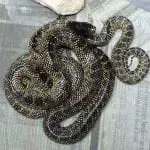Scientific Facts
| Common Name: | Desert Iguana |
| Scientific Name: | Dipsosaurus dorsalis |
| Life Span: | 8 to 12 years |
| Size: | 16 to 18 inches (adult female) |
| Habitat: | Subtropical scrubs, Creosote bush deserts, scattered rocks, loose sands, and vegetation area |
| Country of Origin: | Southwestern United States (Utah, Arizona, Nevada, and South California) and Northwestern Mexico (Sonora, Sinaloa, Baja California) |
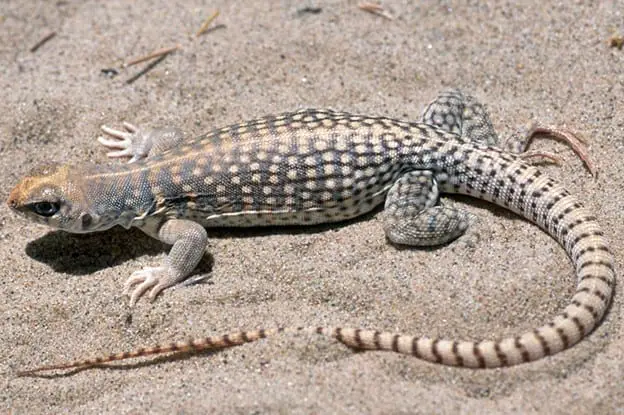
Physical Description
Desert iguana is known for its large and round body that has a reddish-brown netlike pattern in their dorsal surfaces. Its long cylindrical tail has white to gray encircled rows of dark spots. Their color can vary from gray to cream and with a brownish reticulated pattern on their backs and sides. Compared to other iguanas, its head is shorter and more round. A mature lizard can grow up to 10 to 16 inches, although it’s not uncommon to see them grow up to 18 inches. This medium-sized lizard has a bale belly, and their tails can grow about 1 1/2 size of their body.
It’s a wary kind of species that loves to spend time climbing into bushes and seek cooler spots during extreme heat weather conditions. But even if the temperature reaches up to 115 degrees Fahrenheit, these lizards remain active. As its name implies, they can be found in the desert. It’s also natural to see them in subtropical areas. They love to feed on creosote bush flowers and even vegetables, although they can also eat various kinds of insects. During the mating season, the sides of both male and female iguanas changes from brownish to light pinkish color. The femoral cones of the male lizards become enlarged once the breeding months begin. The female can lay 8 to 10 eggs per clutch, and hatching occurs after 2 months or 60 days.
At the present time, these iguanas are not endangered nor threatened. The iguanas are readily available in local pet stores and even through online dealers. They are included on online stock lists from time to time, although their availability can be very rare. To obtain these beautiful iguanas, you should check out private online postings from breeders or keepers. When it comes to legality, desert iguanas can be legally collected in the state of Nevada. But the state requires proper permits. If you’re contemplating on catching these beautiful lizards, then it’s recommended that you look for them in May up to late August. You can start your search early in the morning or during the late afternoon.
Life Span
The recorded lifespan of desert iguanas in a while is more than 7 years. In captivity, male iguanas can live for more than 14 years, provided that you place them in a clean and healthy environment. With proper nutrition and stress-free habitat, they can live as much as 18 years old. These lizards are hardy and resilient when properly nourished. Proper enclosure maintenance is also necessary to extend the lifespan and be able to successfully reproduce. Take note that these lizards require high temperatures. Monitoring and controlling the temperature inside the enclosure is important since high heat is required for them to be able to digest their foods and incubate their eggs.
Their life’s journey begins with an egg. After the male and female have mated, desert iguanas will start digging a burrow in the ground where she can build her nest. The females can lay 8 to 10 eggs, and hatching starts after 60 days. After laying her eggs, she will start to leave the nest and will leave the eggs to hatch and develop on their own. The hatchlings will be to emerge from the eggs after the incubation process is completed. Take note that hatchlings don’t appear at once. What the hatchlings will do to emerge out from the egg is they scratch and create a crack in the shell.
After seeing the hatchlings emerge, you will notice a yolk sac attached to their bodies. The yolk sac will serve as their lifeline, which provides them all the nutrients they need during the incubation period. It will supply them with essential nutrients within 2 to 3 days. And once the sac starts to fall off, the keeper can now start feeding them. It takes about 1 to 2 years before desert iguanas reach their maturity or adulthood stage.
Eating Habits
Primarily, these lizards are herbivores. Desert iguanas are primarily herbivores, and in the wild, they crawl into the branches of shrubs, most especially creosote bushes, to feed on flowers and leaves. Another plant that is commonly part of their diet in the wild is the Alfalfa leaves. Occasionally, you can feed them with crickets, carrion, and mealworms. Their diet also includes squash, pumpkins, tomatoes, corns, berries, sesame seeds, small nuts, and sunflower seeds.
In captivity, keepers feed them with mealworms, dandelion flowers, and some vitamin supplements. You can also feed them with small beetles, ants, and even termites. Feeding on dung or feces of other herbivores is also part of their nature, which is why they are also considered as coprophages.
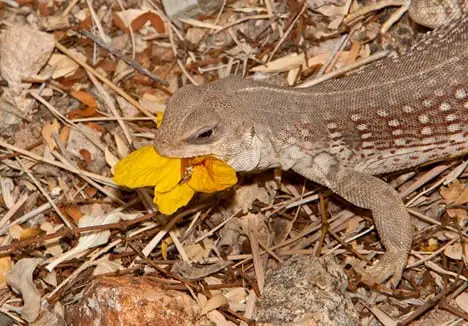
Sleeping Habits
You can find many animals in the wild that do not go into a state that fits the definition of sleep, and the American Bullfrog is one of them. However, although they don’t necessarily fall ‘asleep’, they love to go into rests throughout the day. A study conducted back in the 1960s concluded that Lithobates catesbeianus do not go to sleep. Scientists and researchers have proven that both they and night, they don’t appear to be sleeping at all. Their responses during day and night are almost the same.
Desert iguanas tend to sleep more in captivity than in the wild. It’s typical for them to have a longer sleep in captivity since they are aware that there’s less predation risk. They are known to exhibit behavioral sleep plasticity as a response to potential predation. When sleeping, their sidewinder is more closed than their proximal eyes. It does this to maintain vigilance. In the wild, they tend to spend more time on tree branches or above ground than burrows or holes. Understanding how these lizards sleep is crucial since this gives breeders an idea on how the enclosure should be shaped or the setup.
Development and Reproduction
There’s not enough research and information about the specific aspects of life and the development of desert marijuana in the wild. When it comes to reproduction, these iguanas are considered as polygynous. This means that they can mate with one or more mating partners at a time. It’s also important to note that their breeding system centers on the temperature of their territory. The mating system happens when the bushes or shrubs become cooler and can provide them more food. Take note that these bushes serve as their major food source, and at the same time, it’s also their shelter. It allows them to cool down in hot midday temperatures. The female lizards also develop their territories around them.
When keeping these iguanas, it’s important to understand that they are territorial species. It means that aggression can happen if you place more males inside the enclosure with few females. Males tend to perform ‘push-ups’ when attracting the female ones. Dominant males will try to establish around bushes, shrubs, and deserts to attract more males and give better access to mating.
The mating season of desert iguanas begin in spring and can continue throughout midsummer. The best time for you to breed them is in May and June. Expect them to lay their eggs during late summer. It’s advisable that you only breed them once a year and wait for the female to recover before clutching other batches of eggs. Each of these clutches can contain 3 to 8 eggs. When laying their eggs, it’s natural to see the woman dig the substrate inside the enclosure to create a burrow. Keepers can make their lives easier by providing a burrow or a hole in the ground. And the best way for you to determine whether or not they are already ready to breed is when the side part of their ventral surfaces starts to show punkish pigment.
How to Breed
The pinkish color on their sides signals that the breeding season has already come. Make sure that you continue providing them proper nutrition. And don’t forget to create an excavation inside the enclosure. You can also leave the enclosure or cage as it is without any holes or excavation, but you have to make sure that the substrate can be dug by the female. You can use sand inside the cage for the female to deposit their eggs. The sand or deposition site should be slightly moist. Monitoring the temperature is critical to avoid any stress and to encourage healthy and successful reproduction and deposition of eggs. Experts advise that you keep the subsoil temperature between 82F to 100F or 28C to 38C.
Placing plants or shrubs inside the cage is also a good idea since some iguanas lay their eggs under these plants. Also, it’s a good idea that if you’re creating a burrow, it should be under a plant cover. The goal is to replicate their natural environment when mating or depositing their eggs. You can expect the eggs to hatch between 60 days to 80 days. And as mentioned earlier, you can’t expect them to hatch at once. Keep in mind that higher temperatures reduce the incubation time. After 60 to 80 days, the hatchlings will begin to emerge. A healthy length should be about 5 inches to 5.5 inches or 50 to 60mm. The average annual growth rate of these hatchlings is about 20 to 22m. They should be able to reach reproductive size after 30 to 34 months.
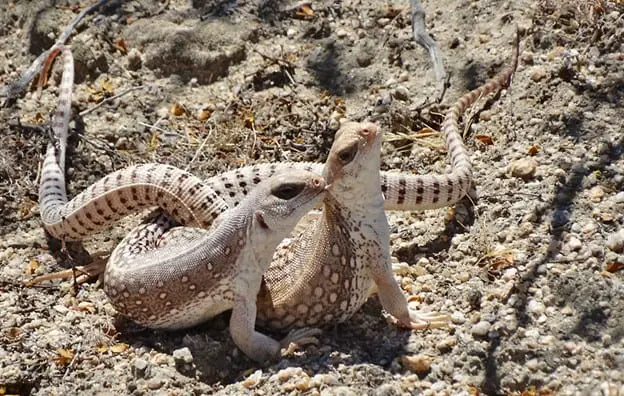
Common Health Problems
Fungal Infections
One of the most common health problems that desert iguanas acquire is a fungus. Caused by fungi, iguanas that have a weak immune system are prone to having this king of infection. It can be very stressful for your iguanas to have fungal infections since it gives them a lot of discomfort. Identifying fungal diseases or infections is easy. Once their color becomes darker and their skin beings crusty, then most probably your iguana is suffering from this health problem. There are also times when you’ll see some black spots and scars in lizards that are affected with fungus. The best way for you to treat fungal infection is by applying antifungal infections. In more serious cases, you must send them to a reliable veterinarian to receive other medications. However, in mild cases, healthy diets and good supplements would suffice. Cleaning the enclosure is very important to avoid these health problems.
Broken Tail and Toes
It’s common to see lizards that have broken tails and toes. Every keeper must treat this health problem as a serious concern. Your iguana is in danger when they have this kind of health problem. It gives them more stress and will experience pain and discomfort. This usually happens when you pull their tails with force. If you notice, these iguanas love to whip their tail. Broken tail tips can lead to poor circulation and will not be able to regenerate. You should apply antibiotic treatment in the broken area and wait for it to heal. Compared to older lizards, younger desert iguanas have a faster regeneration rate.
To avoid broken toes, it’s important that your enclosure is safe for them and does not contain sharp or heavy items that might fall off to their toes or tails. Always check the toes of your iguanas from time to time. You should also make sure that there are no fibers or clothing pieces that are stuck between their toes since it reduces blood flow, and there’s a high probability that they will lose it. Signs of dead toes, including discoloration (black), and stiff to move. If the toe has become black, then it’s time for you to send your iguanas to the vet since it needs amputation to avoid any infection. But if they just injured their toes, then placing a splint such as a toothpick is enough.
Egg Bound Female
Female desert iguanas can produce eggs without male partners. Once the female reaches hormonal maturity, follicles start to form inside her ovaries. The problem with these eggs is most of them don’t have shells. Keepers should watch out for egg bound where the eggs are not able to form from follicles and will begin to get stuck. Female iguanas will start to become weak, depressed, lethargic, and will lose her appetite. You should send your iguana to a reputable veterinarian to perform surgery and get rid of follicles. Treat this health problem very seriously since once the follicles rupture; there’s a high probability that your iguana will die. Also, if she becomes gravid without mating, to ensure her safety, it’s recommended that you go to the vet and perform an X-ray. This is to confirm whether or not she is carrying eggs or follicles.
Internal Parasites
If you catch desert iguanas in the wild, then most probably they carry internal parasites. You don’t want to immediately introduce wild iguanas to your captive ones since they may inherit the parasites. It’s also possible for captive lizards to carry internal parasites. When buying an iguana, you must send them to the vet first before you place it inside the enclosure. Internal parasites include hookworms, roundworms, ringworms, pinworms, protozoans, and nematodes. Your iguana will remain healthy and active even with a lower number of internal parasites, but once the number increases, expect them to feel weaker, lethargic, having problems with digestion, weight loss, and gastrointestinal disorders. There’s also a disturbance in vitamin absorption.
Common signs of internal parasites in desert iguanas are there stools become smell and have different colors. Once you suspect a parasitic infection, you must send them immediately to the vet for treatment or medication. To prevent this health problem, keepers must maintain cleanliness inside the enclosure, the water should be regularly changed.
External Parasites
These iguanas are also prone to external parasites. Ticks and mites love attaching themselves to different parts of your lizard. These parasites will feed on their blood and body. It can be quite tricky to identify external parasites since they usually hide in spots. Check the limbs of your iguanas and their crest scales. Sign of external parasites include agitation, and you’ll notice that your iguanas are rubbing their scales in the walls or bathing and moving around. Remember that these parasites, although small, can bring discomfort to your pet. The good news is, you can easily get rid of them. You can apply mite sprays that are not harmful to your iguana’s health.
If left untreated, the skin of your pet will start to shed and peel. It’s an uncomfortable situation for your beloved lizard. They will start to become weak and will lose interest in eating food. In the later stages of parasitic infections, their skin will start to become black. This is the best time for you to send them to the vet. The vet will give them antibiotics and special reptile ointments that can safely and effectively get rid of mites. Aside from being itchy, these external parasites can also be transferred from one iguana to another
Metabolic Bone Diseases
Commonly found in captive reptiles, metabolic bone diseases, or MPD is a nutritional deficiency of calcium. This is why you must provide enough calcium supplements to your lizards as well as UVB lighting. The lack of a healthy lighting system can cause this health problem. Signs and symptoms of MBD include soft and rubber jaw. You’ll also notice that their eyes begin to start popping. They’ll also find it very difficult to support their body weight. Twitching and jerking also happen when the iguana has MBD. Fortunately, MBD can be treated. During the early stages of the diseases, it’s smart that you send them to the vet. You can also provide calcium supplementation once you start seeing symptoms. To prevent it, you must give your iguana vitamin D3, adequate lighting, and calcium supplements. When giving calcium supplements, you must read the instruction first.
Wounds and Abscesses
Wounds are common to iguanas as they love to move around. It’s their nature to dig, climb, hide, and whip their tail. Unfortunately, there are instances when these lizards become injured or wounded. The best treatment for wounds is to apply antibacterial solutions. Bear in mind that even small wounds can lead to severe health problems such as infections. And aside from wounds, you should also watch out for abscesses. Always examine your iguana and check of infected swelling. Immediate treatment is necessary once you see pus on your pet’s body. An abscess can happen when fungi or bacteria penetrate their tissue. This can happen by bite wounds, trauma, tumor, parasites, and penetration of foreign bodies.
Take note that the pus of these reptiles is unlike human pus. It’s not liquid but rather thick, just like cottage cheese. An abscess can occur almost anywhere on their bodies. Once you see an abscess, make sure that you treat it with appropriate antibiotics. It’s also critical that you go to the vet if the abscess has gotten worse. The vet will perform surgical removal, lancing, and flushing of push and abscess. To prevent an abscess, you must maintain good hygiene inside the enclosure. Get rid of any sharp objects that can cause wounds and injuries.
Behavior
These lizards are active in midday during the spring, summer, and fall season. They are diurnal and can stay active even at high temperatures. Desert iguanas are one of the most resilient reptiles out there that can tolerate extreme heat. They can tolerate up to 40C. They spend most of their time foraging in the wild and finding trees or inclines where they can bask under the sun. Researchers studied their life and activities and found out that they are most active during midday summer since this is when predators don’t go out due to high temperatures.
They are often found in shrubs and bushes such as creosote to find found. It’s also their nature to create their shelter to avoid predators and have a cooler spot to rest when the heat becomes too harsh. During late October, you’ll find these iguanas hibernation, and this continues throughout the winter season. When hibernating, these iguanas will dig or look for burrows or holes. In the wild, their burrows can be as deep as few inches and up to 2 feet under the ground. It’s also not surprising to see young iguanas staying in shallower depths.
It’s also one of the most aggressive iguanas today. They are very territorial and are very alert to their surroundings. Once they feel threatened, they will quickly retreat to their shelters or burrows. Interestingly, these iguanas can inflate their bodies, appearing to be as twice as big as their normal size. This is one of their defense mechanisms or defensive display. Another advantage of this defense mechanism is that when they go inside the burrow and inflate themselves, the predators will have a very hard time getting them out. Moreover, these iguanas also can automatize their tail to escape from threats and predators.
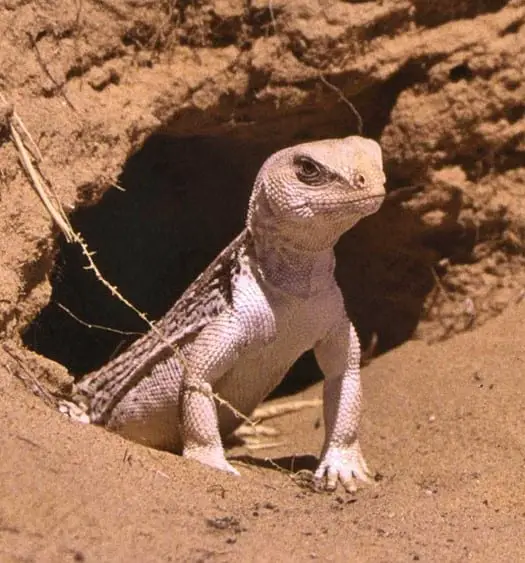
Habitat
Providing proper care to desert iguanas is crucial in order for them to survive in captivity. Their natural habitat plays a critical role in their life and health. To ensure that they remain healthy during captivity, it’s very important that the enclosure is well-maintained. As much as possible, you want to replicate their natural habitat. You don’t just place them in an enclosure without thinking about how they act and live in the wild. This is the key to the successful raising of iguanas. It’s also very important that you know how to control and regulate the environment. Remember that these iguanas are originally from the subtropic regions, therefore, you have to provide them an enclosure that is the right temperature, light, humidity, and even ventilation.
Housing
Caging or housing should be prepared before taking home your desert iguana. Make sure that there is ample space inside the cage for your iguanas to move around. It’s recommended that your cage or hosing has a dimension of 3x2x2 feet high. If you’re planning to breed these iguanas, then the terrarium or cage should be much larger. For keepers who are planning to keep 3 to 4 adult desert iguanas, it’s recommended that they prepare a housing that has a floor space 6×3 feet – although 4×4 ones are also fine. For you to appreciate the beauty of your iguanas, it’s highly recommended that the viewing area is made out of glass. Glass terrariums are best for these reptiles. Take note that they have sharp claws, and if you use plastic cages, they may scratch it. You should also avoid screen housings since they are prone to rubbing their nose against it – this can cause wounds or injuries. It’s also important to provide a screen top on the housing.
Substrate
A deep sandy substrate is perfect for desert iguanas, and it’s suggested that the substrate should be 10 to 12 inches deep. It’s not a good idea to keep 2 males in one enclosure. However, you can place another species that can tolerate the desert-like chuckwallas. Remember to check the quality of the substrate before you place them inside the terrarium. You don’t want to just get sand out from nowhere since these substrates may contain bacteria.
Be sure that the substrate or sand is slightly moist. Create an area inside the cage where they can hide or burrow. The substrate to be soft and moist for them to dig and create burrows. You can keep the enclosure and substrate moist by spraying it from time to time. Space should be large enough for them to move and escape in extreme heat and direct light.
Lighting and Temperature
Proper housing maintenance is necessary if you want to keep desert iguanas and make them reproduce. When it comes to rearing these reptiles, you need to make sure that you provide them sufficient heat and light. We stated earlier that these iguanas extreme heat temperatures for about 40C. Heat is very important in the lives of these reptiles. High temperatures are essential for them to be able to digest their foods. Also, heat is necessary for incubation eggs and optimal growth and development of hatchings. It’s recommended that you place a thermometer or any device that can monitor the temperature inside the enclosure. It’s recommended that you keep the temperature from 32 to 40C.
You can use heat lamps and heat pads to increase the temperature inside the terrarium. Check the wattage of the lamps and install those that are energy efficient. These lamps should also be bright since bright lights enhance their growth and development. Light also aids in keeping them healthy. According to studies, desert iguanas that are exposed to bright light grow a lot quicker than those that are kept in an enclosure that has dim light. The light cycle should be at least 12 hours a day. Also, don’t forget to keep the humidity level between 15% and 30%.
Food and Water
Feeding your desert iguana can be a fun and exciting experience. However, you have to keep track of what you’re feeding them. What’s great about these iguanas is that they can eat a wide range of fruits, vegetables, and insects. Also, don’t forget how important it is to provide your iguanas with a clean and healthy water source. Some experts give moisty leafy vegetables to their iguanas since some don’t drink reliable from the water bowl. Adding insects to their diets, such as ants and beetles, is also healthy. However, keep in mind that insects should only be a small percentage of their natural diet. Also, you need to know that these herbivores should be feed in bulk more often. They have a longer digestion process and so be sure that food is always available. However, you should avoid overfeeding your iguanas since this can lead to many health problems. Of course, be sure that you provide them with supplements such as calcium powder, vitamin D3, and potassium.
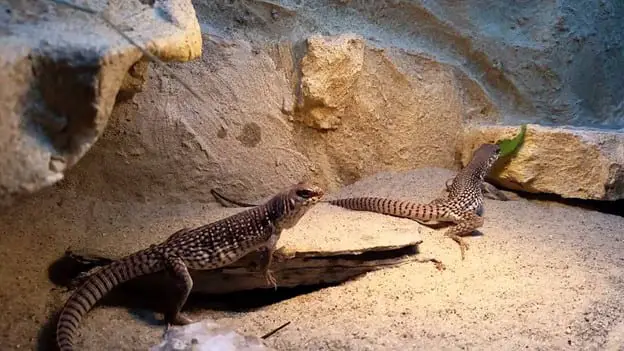
How to Care for Desert Iguana
The key to proper desert iguana care is to replicate their natural environment. Make sure that you’re ready to take care of these beautiful pets before you decide to buy one. Remember that you have to invest some of your money in providing their needs. You need to have adequate space for the enclosure or housing. You must also make sure that you have monitoring devices that can help you keep track of the temperature, humidity, and light inside the cage or terrarium.
We’ve already mentioned the common health problems that desert iguana may acquire. Proper care means knowing how to avoid these health problems. One of the best things you can do as a desert iguana keeper is to make sure that the enclosure is clean and safe. You should also spend time examining the condition of your reptiles. Going to the veterinarian is also a good practice. Be observant, and always check the health of your pet. If you think that they are getting weak or lethargic, then don’t hesitate to call a vet or go to the nearest clinic.
If you’re a beginner, then don’t be shy to ask for tips or guidelines from people who have experienced taking care of desert iguanas. You might know someone in the family or perhaps a friend who has these kinds of pets, and so, ask them for recommendations or pointers on how you can keep your pet healthy. These lizards are fairly docile, and they can be accustomed to their owners. Gentle handling is required, though. However, be warned that newly captured iguanas may bite you and can break your skin or can cause small wounds. Conduct thorough online research first before you decide to raise desert iguanas.
Availability – Where to Get One?
Owning a desert iguana is easy since you can find them in your local pet stores. You can also find them online. You can check out and buy these beautiful reptiles on Snake and Sunset, Backwater Reptiles, and Underground Reptiles.
FAQ Section
Is desert iguana dangerous?
These iguanas are fairly docile, and they are primarily herbivores. Therefore, there’s no need for you to worry about getting attacked in the wild.
How do they survive in the desert?
They are pretty resilient and can survive even in extreme heat. Thanks to their smart nature and incredible instinct, they are able to easy burrow themselves near shrubs or sand hummocks. This behavior has two purposes, to escape the heat and avoid predators.
Are they venomous?
The bite of desert iguana contains small amounts of venom, which can effectively knock down smaller mammals. However, their bite and venom are harmless to human beings.
Are they good pets?
Yes, they are since they are hardy and docile. What’s more is that they are very easy to feed. Taking care of them is also easy so long as you provide them right environment and nourishment. Keeping these iguanas is definitely a very rewarding experience.
Are they fast runners?
These iguanas have powerful back legs and can run at high speeds. Be very careful when handling them, and make sure that they don’t escape since it can be quite challenging to catch them.
What do desert iguanas eat?
They can eat fruits, vegetables, perennial plants, and even insects.
How long do they live?
The iguanas can live up to 17 years in captivity.
How big can they get?
They can grow about 16 to 18 inches. Their bodies are long and around. They are also known for their beautiful marks and long tail.
Are they nocturnal?
Desert iguanas are diurnal, which means that they are more active during the daytime.
Are they intelligent?
They are considered as one of the smartest reptiles on the planet.

